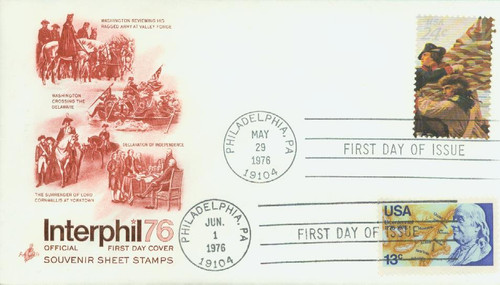
1976 24c Men on Shore
# 1688e FDC - 1976 24c Men on Shore
$4.50 - $5.50
U.S. #1688e
1976 24¢ Washington Crossing the Delaware
American Bicentennial Issue
American Bicentennial Issue
Issue Date: May 29, 1976
City: Philadelphia, PA
Quantity: 1,990,000
Printed By: Bureau of Engraving and Printing
Printing Method: Lithographed
Perforations: 11
Color: Multicolored
Emanuel Leutze’s painting, “Washington Crossing the Delaware,” is perhaps one of the best known Revolutionary War paintings. Each year, thousands of visitors see the original, which hangs in the Washington Crossing, PA. The scene depicts General George Washington and several of his men ferrying across the ice-clogged Delaware to stage a surprise attack on the Hessians.
Following the Battle of White Plains in October 1776, the patriots retreated and the British marched on to Manhattan. There, after a brief struggle, the Continental Army surrendered Fort Washington to the enemy. The loss opened the way to New Jersey, and the redcoats quickly poured in. Meanwhile, the patriots retreated to safety behind the Delaware River.
On Christmas night, 1776, patriot troops re-crossed the Delaware River, assembled swiftly, and then silently marched on toward Trenton, N.J., where Hessian troops were garrisoned. The men were taken by surprise, and over 1,000 prisoners were captured. Washington then marched on to Princeton, where he won a brilliant victory.
Leutze painted his well-known work in Germany, using the Rhine as a model for the Delaware. Interestingly, the flag shown in the picture is not the correct flag for the time period. Leutze’s flag shows the familiar “Stars and Stripes” with 13 stars. However, this format was not in use until June 14, 1777, when Congress adopted the following resolution: “resolved, that the flag of the 13 United States be 13 stars, white on a blue field, representing a new constellation.” Up until that time, a flag with 13 red and white stripes, with the British emblem in the upper-left corner, was used.
The Bicentennial Series
The U.S. Bicentennial was a series of celebrations during the mid-1970s that commemorated the historic events leading to America’s independence from Great Britain. The official events began on April 1, 1975, when the American Freedom Train departed Delaware to begin a 21-month, 25,338-mile tour of the 48 contiguous states. For more than a year, a wave of patriotism swept the nation as elaborate firework displays lit up skies across the U.S., an international fleet of tall-mast sailing ships gathered in New York City and Boston, and Queen Elizabeth made a state visit. The celebration culminated on July 4, 1976, with the 200th anniversary of the adoption of the Declaration of Independence.
The U.S.P.S. issued 113 commemorative stamps over a six-year period in honor of the U.S. bicentennial, beginning with the American Revolution Bicentennial Commission Emblem stamp (U.S. #1432). As a group, the Bicentennial Series chronicles one of our nation’s most important chapters, and remembers the events and patriots who made the U.S. a world model for liberty.
U.S. #1688e
1976 24¢ Washington Crossing the Delaware
American Bicentennial Issue
American Bicentennial Issue
Issue Date: May 29, 1976
City: Philadelphia, PA
Quantity: 1,990,000
Printed By: Bureau of Engraving and Printing
Printing Method: Lithographed
Perforations: 11
Color: Multicolored
Emanuel Leutze’s painting, “Washington Crossing the Delaware,” is perhaps one of the best known Revolutionary War paintings. Each year, thousands of visitors see the original, which hangs in the Washington Crossing, PA. The scene depicts General George Washington and several of his men ferrying across the ice-clogged Delaware to stage a surprise attack on the Hessians.
Following the Battle of White Plains in October 1776, the patriots retreated and the British marched on to Manhattan. There, after a brief struggle, the Continental Army surrendered Fort Washington to the enemy. The loss opened the way to New Jersey, and the redcoats quickly poured in. Meanwhile, the patriots retreated to safety behind the Delaware River.
On Christmas night, 1776, patriot troops re-crossed the Delaware River, assembled swiftly, and then silently marched on toward Trenton, N.J., where Hessian troops were garrisoned. The men were taken by surprise, and over 1,000 prisoners were captured. Washington then marched on to Princeton, where he won a brilliant victory.
Leutze painted his well-known work in Germany, using the Rhine as a model for the Delaware. Interestingly, the flag shown in the picture is not the correct flag for the time period. Leutze’s flag shows the familiar “Stars and Stripes” with 13 stars. However, this format was not in use until June 14, 1777, when Congress adopted the following resolution: “resolved, that the flag of the 13 United States be 13 stars, white on a blue field, representing a new constellation.” Up until that time, a flag with 13 red and white stripes, with the British emblem in the upper-left corner, was used.
The Bicentennial Series
The U.S. Bicentennial was a series of celebrations during the mid-1970s that commemorated the historic events leading to America’s independence from Great Britain. The official events began on April 1, 1975, when the American Freedom Train departed Delaware to begin a 21-month, 25,338-mile tour of the 48 contiguous states. For more than a year, a wave of patriotism swept the nation as elaborate firework displays lit up skies across the U.S., an international fleet of tall-mast sailing ships gathered in New York City and Boston, and Queen Elizabeth made a state visit. The celebration culminated on July 4, 1976, with the 200th anniversary of the adoption of the Declaration of Independence.
The U.S.P.S. issued 113 commemorative stamps over a six-year period in honor of the U.S. bicentennial, beginning with the American Revolution Bicentennial Commission Emblem stamp (U.S. #1432). As a group, the Bicentennial Series chronicles one of our nation’s most important chapters, and remembers the events and patriots who made the U.S. a world model for liberty.












